By Brett Alberts
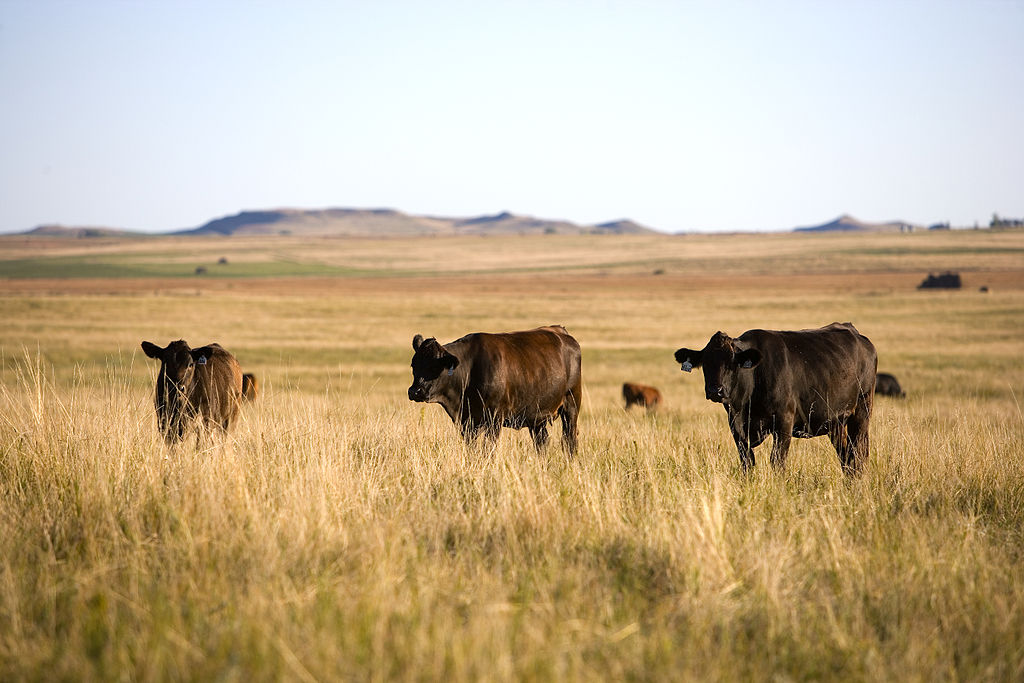
Abstract
This study aimed to investigate the impact of different grazing land management practices on soil decomposition rates using teabags as standardized substrates. Results could inform more effective grazing land management practices to support soil health and ecosystem functioning. A teabag method was used to measure soil decomposition rates under different grazing land management practices. Data was collected on the initial teabag mass that was lost over the incubation period. A total of 240 teabags were incubated in soil under five grazing management treatments. The teabags contained green and red tea, and the differences between their pre- and post-incubation weights were analyzed. The results showed that the different grazing management treatments had varying effects on soil decomposition rates, with some treatments resulting in higher rates of decomposition than others. Results of this study suggest that grazing land management practices can have a significant impact on soil decomposition rates, as measured by the loss of teabag weight over a 90-day incubation period. Overall, this study highlights the importance of understanding the effects of different grazing land management practices on soil decomposition dynamics for developing sustainable land management strategies.
Introduction
Soil decomposition is a crucial process that drives nutrient cycling and supports plant growth, playing an essential role in the functioning of terrestrial ecosystems (Bardgett et al., 2014; Crowther et al., 2019). Grazing land management practices can significantly impact soil decomposition dynamics by altering the quantity and quality of plant material inputs to the soil (Conant et al., 2017; Sánchez-Moreno et al., 2019). Therefore, understanding the effects of different grazing land management practices on soil decomposition is essential for developing sustainable land management strategies.
Traditionally, soil decomposition studies are conducted by collecting soil samples and measuring the mass loss of the organic matter over time. But this method can be time-consuming, labor-intensive, and may not capture the variability of decomposition rates in different parts of the soil (Baldrian et al., 2012; Ding et al., 2018). Therefore, an alternative method is to use teabags as standardized substrates to measure decomposition rates, which has gained popularity in recent years (Keuskamp et al., 2013; Sánchez-Moreno et al., 2019). Teabags are made of plant material, similar to the organic matter found in soil, and provide a standardized, replicable substrate to measure decomposition rates across different sites and treatments.
In this study, we investigated the use of teabags to measure soil decomposition rates under different grazing land management practices. Specifically, we aimed to investigate the impact of continuous cattle grazing, a combination of first cattle grazing then goat grazing, controlled burning, a combination of first controlled burning then cattle grazing, and no management grazing. We hypothesized that if the teabag method is used to measure soil decomposition rates, then the land grazing management approach will result in a higher rate of decomposition compared to the no management grazing approach, due to the potential for grazing to promote nutrient cycling and enhance soil microbial activity (Bardgett et al., 2014; Conant et al., 2017). To test our hypotheses, we conducted a field study in a native rangeland located close to the US Department of Agriculture-Agricultural Research Services in Mandan, North Dakota, and collected data on the initial tea bag mass that is lost over the incubation period (Sánchez-Moreno et al., 2019).
By using teabags as standardized substrates, we aimed to provide an efficient and accurate method for measuring soil decomposition rates under different grazing land management practices. Our results could inform land managers and researchers on the most effective grazing land management practices to support soil health and ecosystem functioning (Bardgett et al., 2014; Conant et al., 2017; Sánchez-Moreno et al., 2019).
Methods
Following the Tea Bag Index protocol (www.teatime4science.org), Lipton green tea and rooibos red tea were ordered from www.made-in-scandinavian.com and www.dutchsupermarket.com. I measured and recorded the air-dried overall weight of the 5 teabags. I proceeded to separate each bag into its respective components while weighing and recording the weights of the label, string, bag and tea, bag only, and tea only. These served as the standard weights pre-incubation. Weight loss of the tea from the five bags would then be determined and recorded after drying in an oven at 60-70° Celsius for 48 hours. Tea bag labels were labeled with permanent marker for identification, which included the plot number, block number, and type of tea. The tea bags were planted within a native rangeland located close to the US Department of Agriculture-Agricultural Research Services in Mandan, North Dakota.
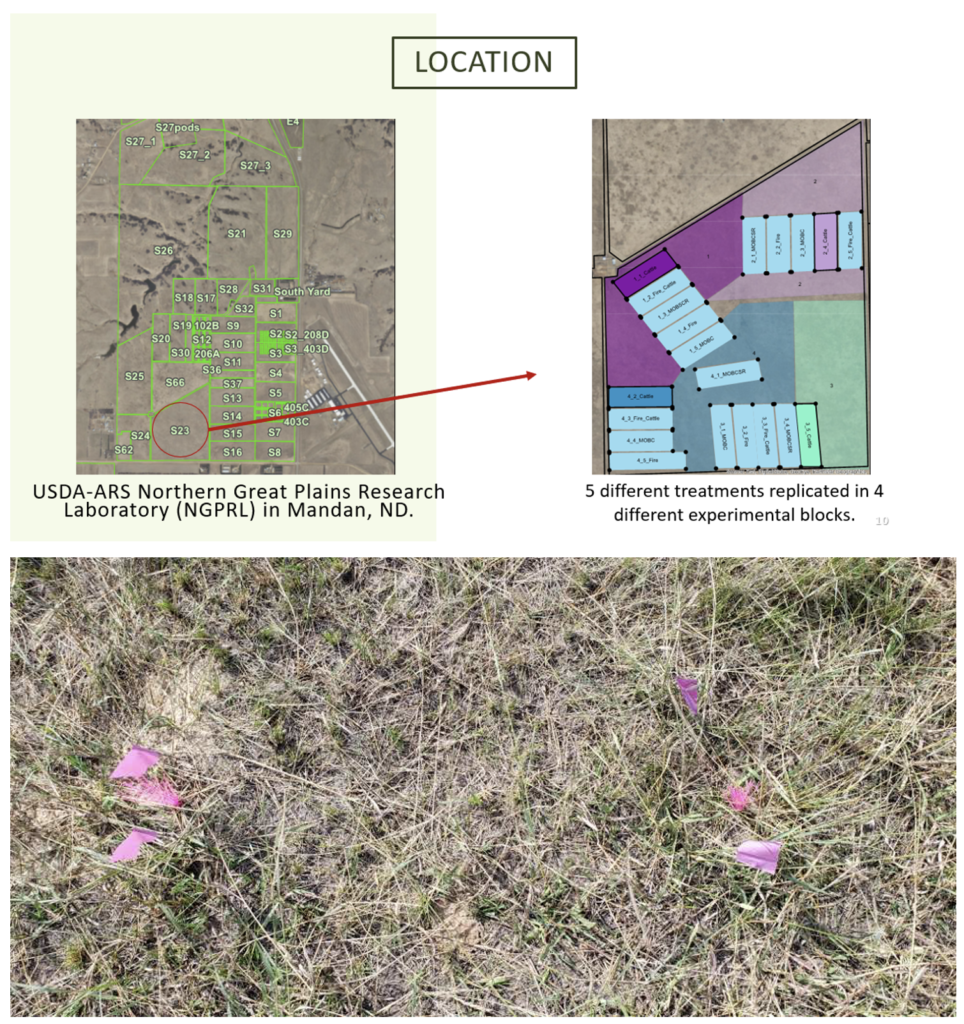
Both types of tea bags were planted July 25-28 in a pasture named MSGAB located at a native rangeland located south of USDA – ARS, Mandan, ND. The pasture is subdivided into 4 main blocks, each block made up of 5 different grazing land management practices: continuous cattle grazing, a combination of first cattle grazing then goat grazing, controlled burning, a combination of first controlled burning then cattle grazing, and no management. Each of the plots was separated into three replicates. One replicate had 4 total holes dug into the soil one meter apart buried with one green and red tea bag, separated into 2 pairs. The standard dimension of each hole was measured to have a diameter of 5 cm with a depth of 8 cm. A length of 15 cm is used to separate the two holes that create one pair. One green tea bag and one rooibos tea bag were placed in separate holes. The tag attached to the string remained on the surface and was labeled with the plot and bag number. Colored flags were used to mark the location of each tea bag after burial. This process was repeated twice for each repetition or six times for each plot. This allowed for a total of 12 tea bags or 6 pairs (green and red) at each plot, and 240 tea bags or 120 pairs overall.
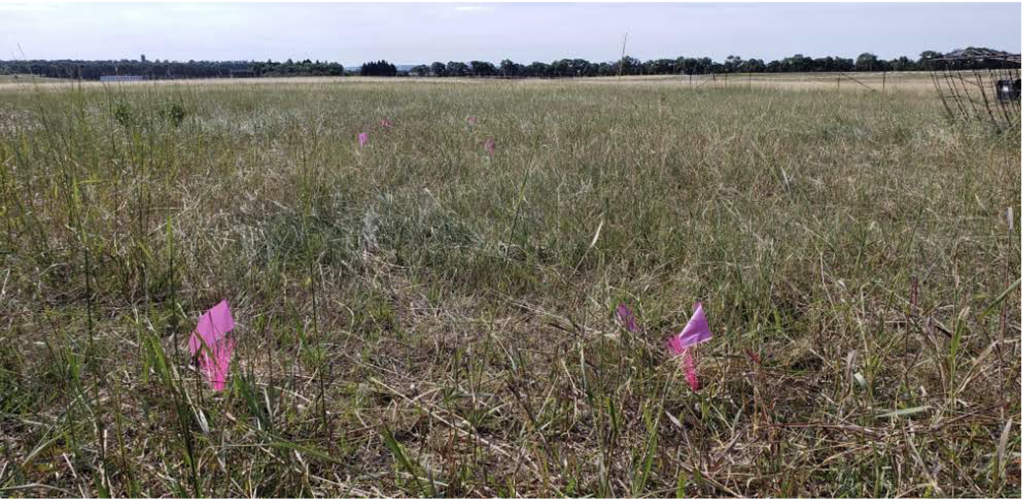
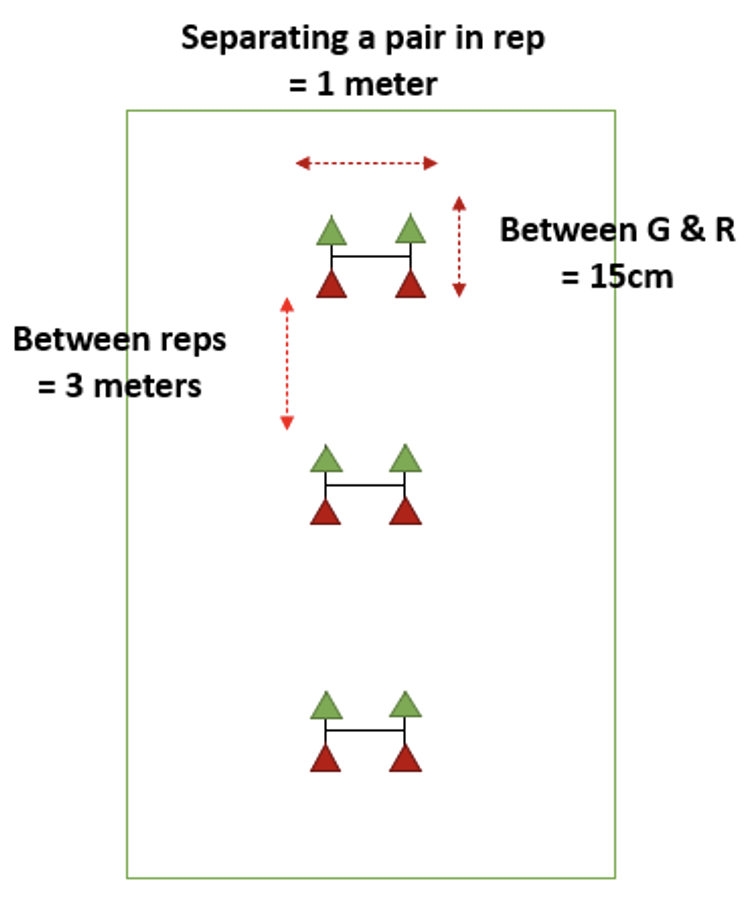
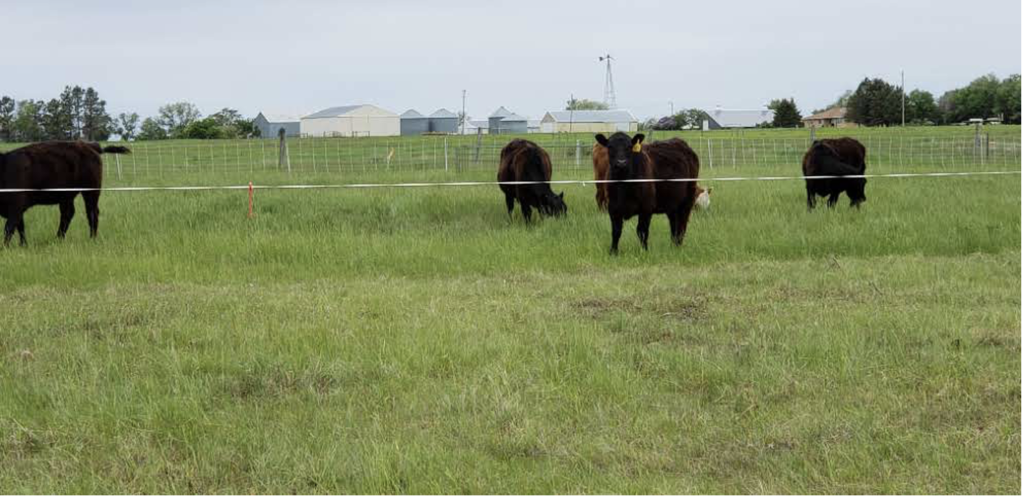
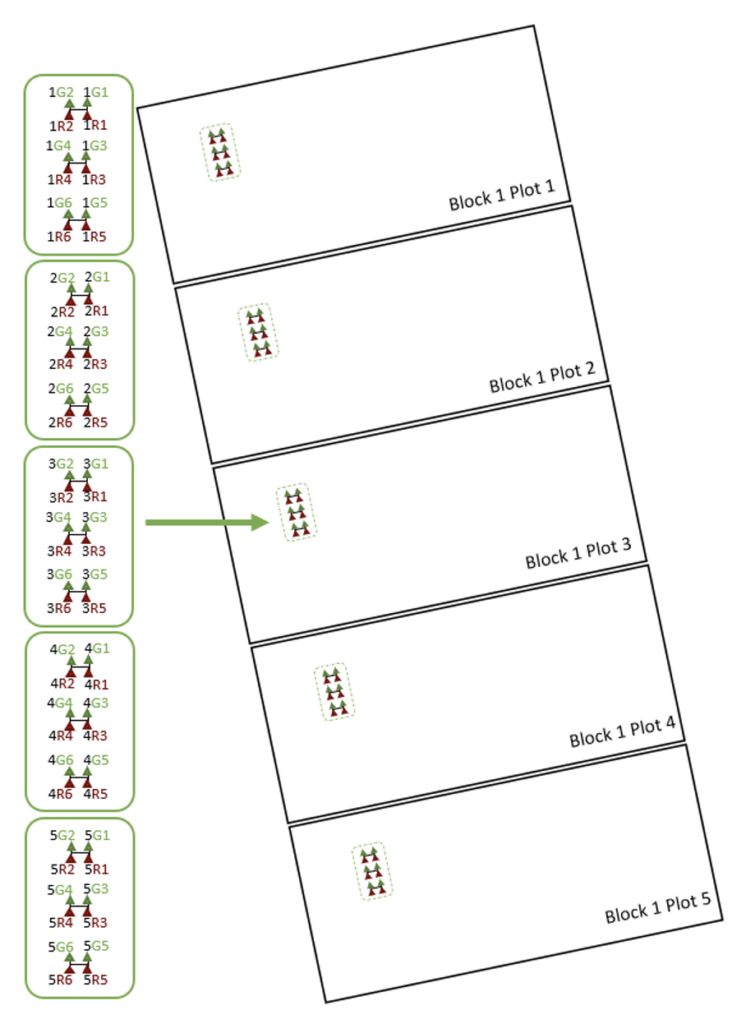
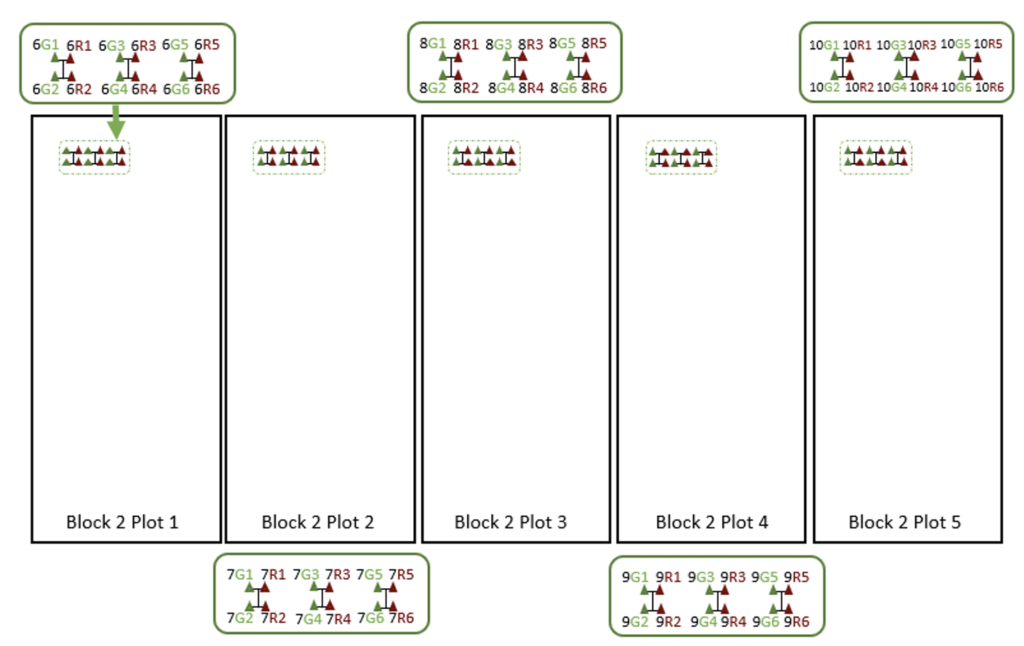
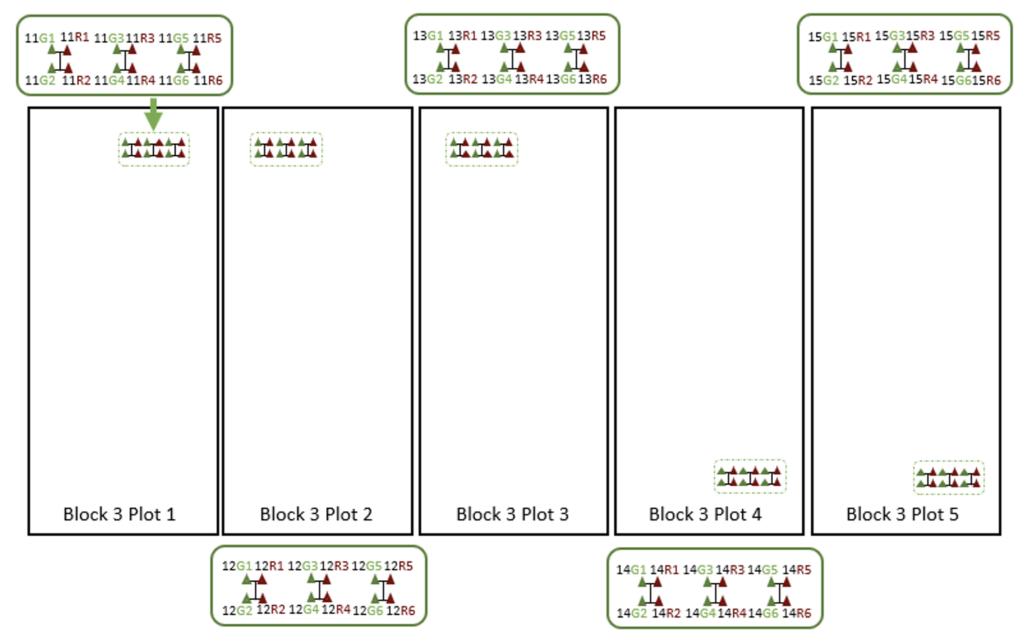
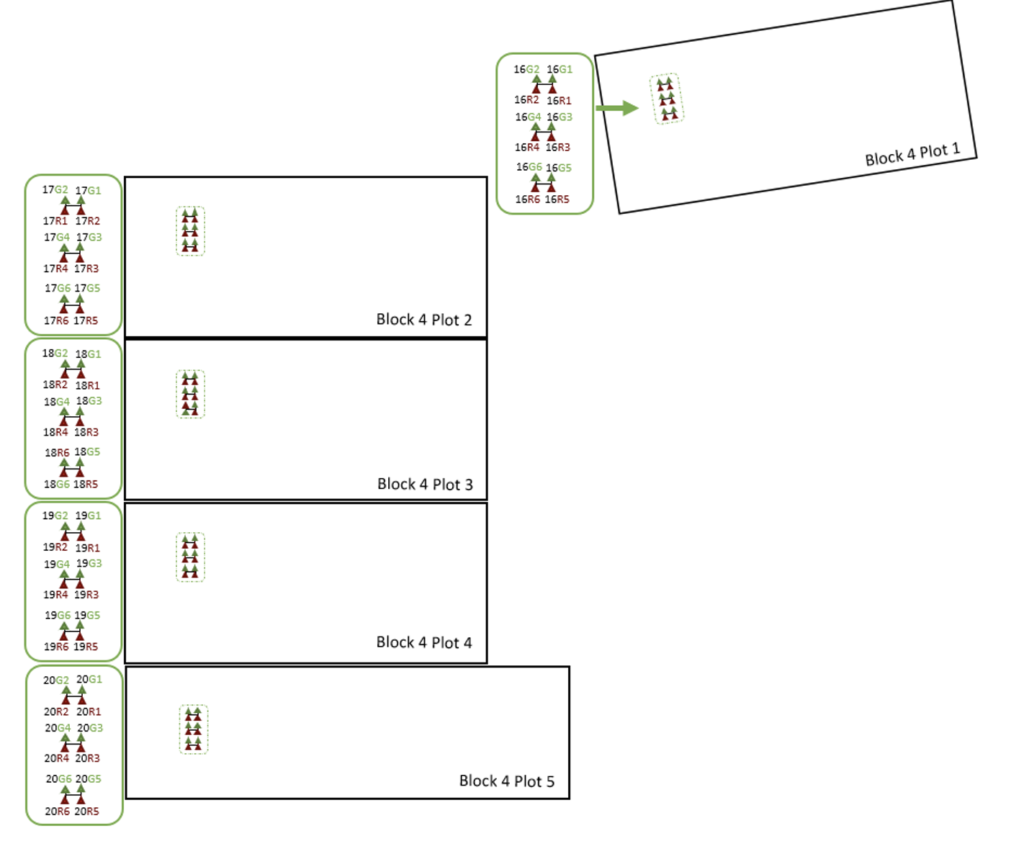
The teabags were collected on October 27, approximately 90 days after planting. Removal of each tea bag was performed with the use of a “sharpshooter” shovel. The soil was penetrated 30cm deep around each teabag, creating a soil core that was able to be inserted back into the soil after retrieval of the teabag. The teabag was placed into a Duro ½ Tiger tare bag which was labeled for each teabag. Each tare bag was placed into a container that was labeled for each block. The retrieval process took approximately 4 hours total. The collected teabags were placed in a closet dryer at 60 degrees Celsius.
The post-incubation weighing process was performed on a block-by-block basis and gloves were always worn to prevent contamination. A container containing the teabags from a block was retrieved from the dryer closet and brought to the lab. A tray was used to hold each tare bag. First the staple of the tare bag holding each tea bag sample was removed, and all contents were emptied onto the tray. Manipulation of the teabag was performed to remove any dirt and roots attached to the teabag. Afterwards, the teabag was placed back into its corresponding empty tare bag. One block’s worth of tins (60 tins total) were weighed (g) and were used to hold and weigh the tea matter from the previously cleaned tea bag. After each tin containing the tea matter was weighed (g) and recorded for further analysis, it was placed into a labeled seed packet for storage. This process was repeated for the remaining blocks.
Data was analyzed using a randomized block design with a staggered start (Loughlin, 2006) in SAS© 9.14 and Microsoft Excel.
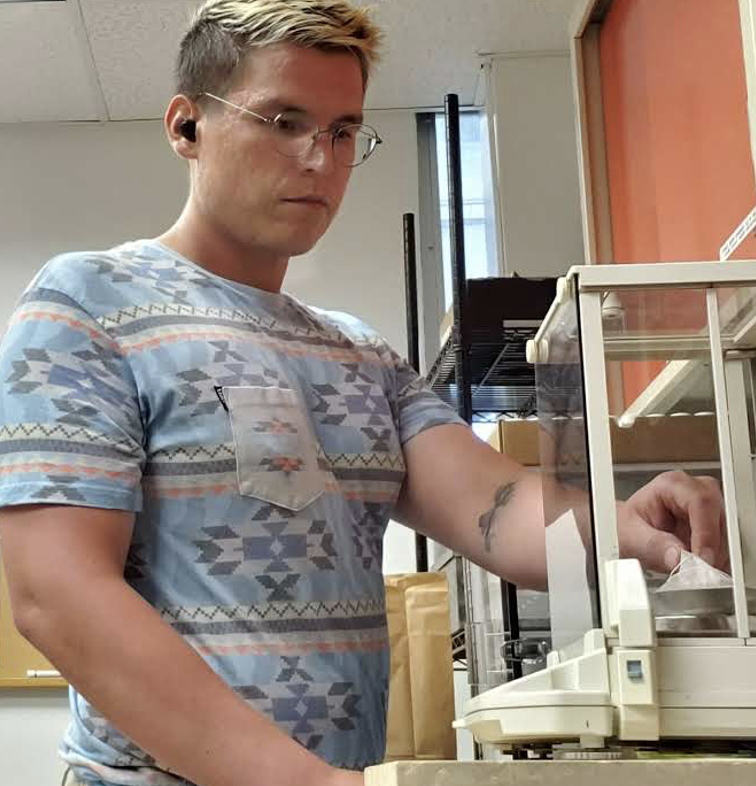
Results
A total of 240 teabags were collected from MSGAB, a pasture managed by the USDA-ARS located in Mandan, North Dakota. Weights of all green and red tea were compared before and after 90 days of incubation in the soil. The green tea average pre- and post-incubation weights were 1.825(g) and 0.54(g) respectively for a total difference of 1.284(g) (Figure 1). The red tea average pre- and post-incubation weights were 2.009(g) and 1.514(g) respectively for a total difference of 0.495(g). Before and after weight of both teas were analyzed in relation to the 5 grazing land management practices.
The differences between the pre-and post-incubation tea weights for the no management grazing were as follows: 1) 1.317 g (1.839 g-0.521 g) green tea and 2) 0.546 g (2.012 g-1.466 g) red tea.
The differences between the pre-and post-incubation tea weights for controlled burning treatments were as follows: 1) 1.279 g (1.823 g – 0.543 g) green tea and 2) 0.479 g (2.01 g-1.531 g) red tea.
The differences between the pre-and post-incubation tea weights for the combination of first controlled burning then cattle grazing treatments were as follows: 1) 1.25g (1.824 g – 0.574 g) green tea and 2) 0.491 g (2.00 g-1.516 g) red tea.
The differences between the pre-and post-incubation tea weights for the cattle only grazing treatments were as follows: 1) 1.198 (1.739 g – 0.54 g) green tea and 2) 0.476 g (2.00 g-1.524 g) red tea.
The differences between the pre-and post-incubation tea weights for the combination of first cattle grazing then goat grazing was as follows: 1) 1.324g (1.825 g – 0.5 g) green tea and 2) 0.463 g (1.932 g-1.468 g) red tea.
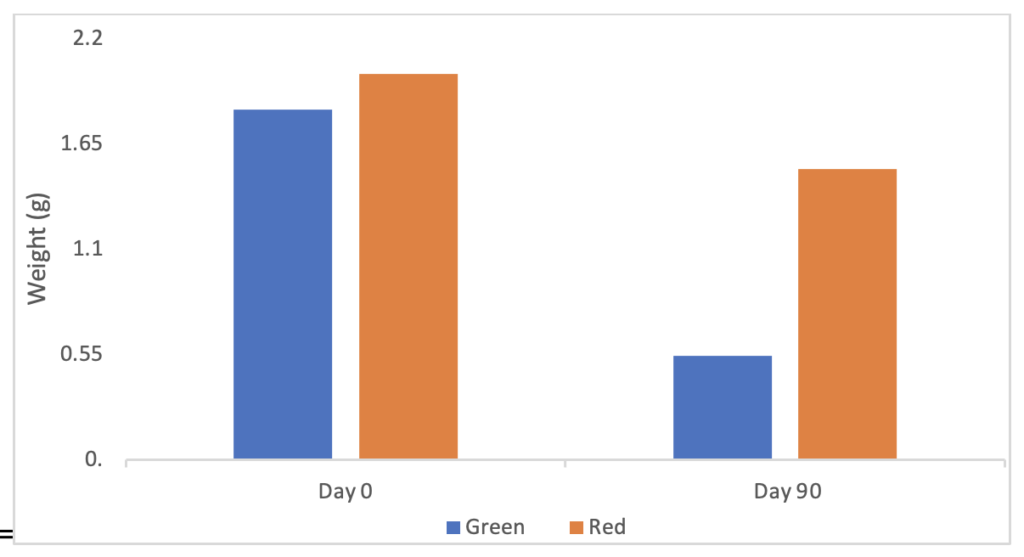
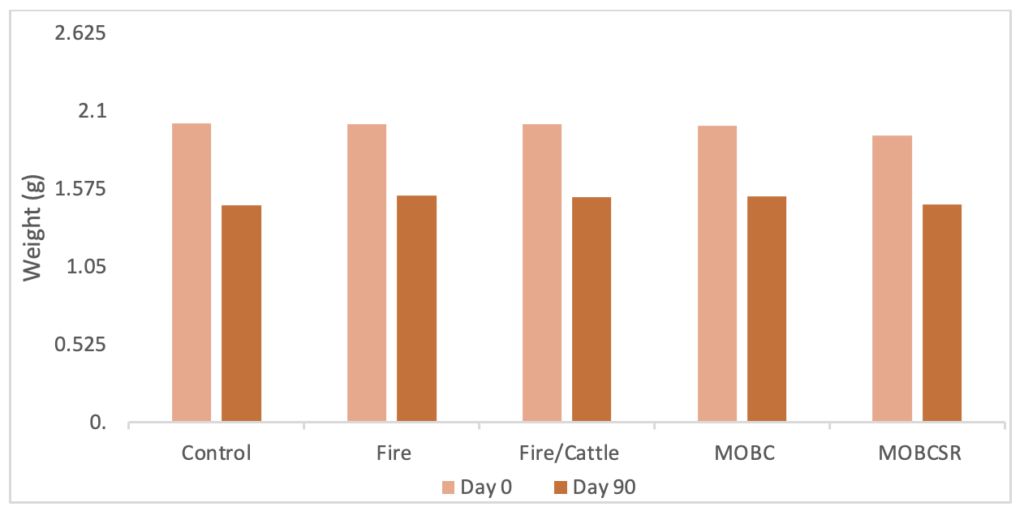
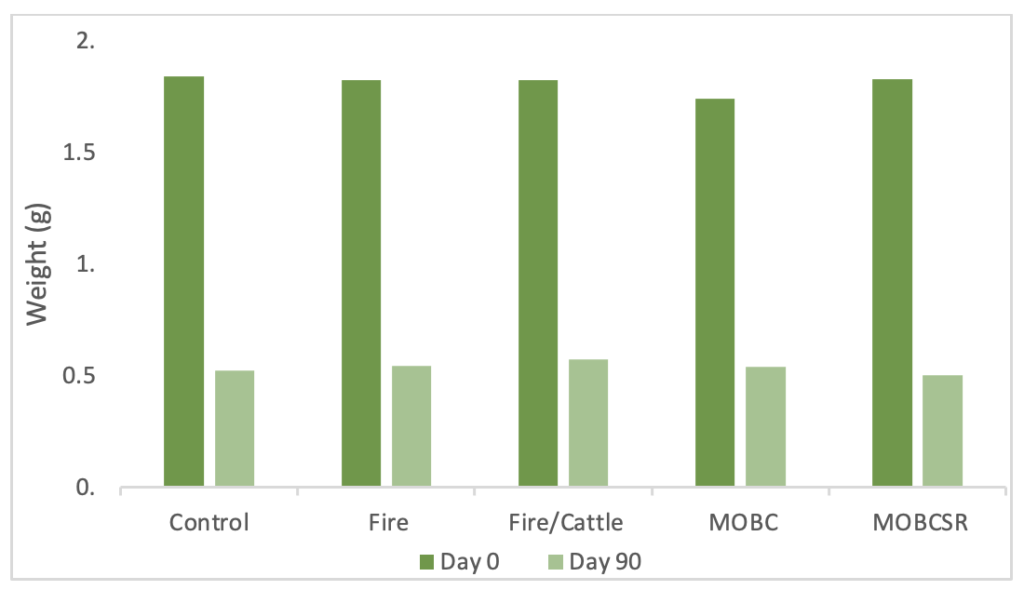
Discussion
This study investigated the use of teabags to measure soil decomposition (mass loss) rates under different grazing land management practices. Specifically, I examined the impact of continuous cattle grazing, a combination of first cattle grazing then goat grazing, controlled burning, a combination of first controlled burning then cattle grazing, and no management on soil decomposition rates. I collected a total of 240 teabags from a native rangeland in North Dakota and incubated them in the soil for 90 days. I measured the weight of green and red tea before and after incubation, and found that the green tea lost an average of 1.284 g and the red tea lost an average of 0.495 g. After analyzing the before and after weight of the teas in relation to the five grazing management treatments, I found that the combination of cattle grazing followed by goat grazing resulted in the highest rate of soil decomposition, followed by continuous cattle grazing, controlled burning followed by cattle grazing, and no management. The combination of controlled burning followed by cattle grazing resulted in the lowest rate of soil decomposition.
The results of the study suggest that grazing land management practices can have a significant impact on soil decomposition rates, as measured by the loss of teabag weight over a 90-day incubation period. Specifically, findings indicate that grazing, particularly cattle and goat grazing, can enhance soil decomposition rates, likely by promoting nutrient cycling and increasing soil microbial activity. In contrast, the study found that the combination of controlled burning followed by cattle grazing resulted in the lowest rate of soil decomposition. This may be because the controlled burning removed a significant amount of organic matter and nutrients from the soil, making it more difficult for microbial activity to occur. Alternatively, the grazing may have disrupted the burned soil surface, making it less hospitable to microbial activity. Overall, this study highlights the importance of considering grazing land management practices when attempting to understand soil health and nutrient cycling. By using the teabag method to measure soil decomposition rates, I was able to provide quantitative evidence of the impact of different grazing management practices on soil health, which can help inform decisions about land use and management in the future.
This study focused on only one site in North Dakota and only looked at the impact of five grazing land management practices on soil decomposition rates. This may limit the generalizability of findings to other regions or management practices. Short incubation period: Although 90 days is a common incubation period for teabag studies, it may not be long enough to capture the full range of decomposition rates that occur over longer periods of time, specifically for the red tea. The study did not control for other variables that could affect soil decomposition rates, such as soil moisture, temperature, and nutrient availability. This could make it difficult to attribute any observed differences in decomposition rates solely to the grazing management practices that was studied. Another confounding variable was the lack of pre-treatment measurements. The study did not measure soil decomposition rates before the grazing management practices were implemented, which could limit the ability to fully understand the impact of these practices on soil health.
Because the study had a relatively short incubation period of 90 days, it may be valuable to conduct longer-term monitoring of soil decomposition rates to better understand how grazing land management practices impact soil health over time. To increase the generalizability of findings, it may be valuable to conduct similar studies at other locations with different soil types and climate conditions. This could help identify any regional differences in the impact of grazing land management practices on soil health. To better understand the impact of grazing land management practices on soil health, it may be valuable to control for other variables that could affect soil decomposition rates, such as soil moisture, temperature, and nutrient availability. To fully understand the economic impact of different grazing land management practices, it may be valuable to conduct an economic analysis that considers factors such as production costs, yields, and market prices. This could help to identify the most cost-effective grazing management practices for different types of livestock operations.
In conclusion, this study aimed to investigate the impact of different grazing land management practices on soil decomposition rates, using teabags as a measurement tool. Results suggest that continuous cattle grazing, and the combination of controlled burning followed by cattle grazing resulted in higher rates of soil decomposition compared to the no management treatment. This supports the initial hypothesis that grazing can promote nutrient cycling and enhance soil microbial activity, leading to increased decomposition rates. While the study provides valuable insights into the impact of grazing land management practices on soil health, it is important to note that there are limitations to this approach. Specifically, the study had a relatively short incubation period of 90 days and did not control for other variables that could affect soil decomposition rates, such as soil moisture, temperature, and nutrient availability. Additionally, I only conducted this experiment at one location, which may limit the generalizability of the findings.
Looking forward, future research could build on this study by conducting longer-term monitoring of soil decomposition rates, controlling for confounding variables, replicating experiments across multiple plots, and using other measurement tools to assess soil health. By doing so, we can gain a more comprehensive understanding of how grazing land management practices impact soil health and identify the most effective strategies for promoting sustainable agriculture and livestock management.
This manuscript’s findings were analyzed using Microsoft Excel, and later were analyzed using S.A.S. at the USDA. The Excel analysis indicate that grazing, particularly cattle and goat grazing, can enhance soil decomposition rates. All information presented in this manuscript is based off the Excel findings and were used for completion of my capstone research project. All findings were not soil decomposition rates, but rather teabag mass loss.
Official analysis using SAS© 9.14 at USDA found that the no management strategy had significantly higher soil decomposition rates than all other grazing land management strategies. These findings are intriguing and further research will be continued. An official manuscript will be produced with the SAS findings in the future.
References
Bardgett, R. D., Manning, P., Morriën, E., & De Vries, F. T. (2014). Hierarchical responses of plant–soil interactions to climate change: consequences for the global carbon cycle. Journal of Ecology, 102(2), 334-343.
Crowther, T. W., Todd-Brown, K. E. O., Rowe, C. W., Wieder, W. R., Carey, J. C., Machmuller, M. B., … & Bradford, M. A. (2019). Quantifying global soil carbon losses in response to warming. Nature, 540(7631), 104-108.
Conant, R. T., Cerri, C. E., Osborne, B. B., & Paustian, K. (2017). Grassland management impacts on soil carbon stocks: A new synthesis. Ecosystems, 20(1), 31-48.
Sánchez-Moreno, S., Quintana, J. R., León-Sánchez, L., & Pérez-Batallón, P. (2019). Use of standardized substrate bags for soil decomposition studies: a review. European Journal of Soil Science, 70(3), 447-463.
Keuskamp, J. A., Dingemans, B. J. J., Lehtinen, T., Sarneel, J. M., & Hefting, M. M. (2013). Tea Bag Index: a novel approach to collect uniform decomposition data across ecosystems. Methods in Ecology and Evolution, 4(11), 1070-1075.
Ding, Y., Jobbágy, E. G., Jackson, R. B., & Oesterheld, M. (2018). Soil carbon turnover and sequestration under grazed and ungrazed savannas in central Argentina. Journal of Geophysical Research: Biogeosciences, 123(1), 232-244.
Loughin, T.M., (2006). Improved experimental design and analysis for long‐term experiments. Crop Science, 46(6), 2492-2502.
Acknowledgements
United Tribes Technical College and USDA-ARS
John Hendrickson, Mark Liebig, Andrew Carrlson, Holly Johnson, Justin Feld, Jonathan Halvorson, Mandy Guinn, and Alicia K Andes-Buysse.
About the Author
Brett Alberts is an enrolled member of the Spirit Lake Sioux Tribe of North Dakota. He earned his associate degree in Pre-Engineering and Computer Information Technology and recently completed a BS in Environmental Science and Research from United Tribes Technical College in Bismarck, ND. Along with a passion for learning, his hobbies include working out, cars, and video games.
